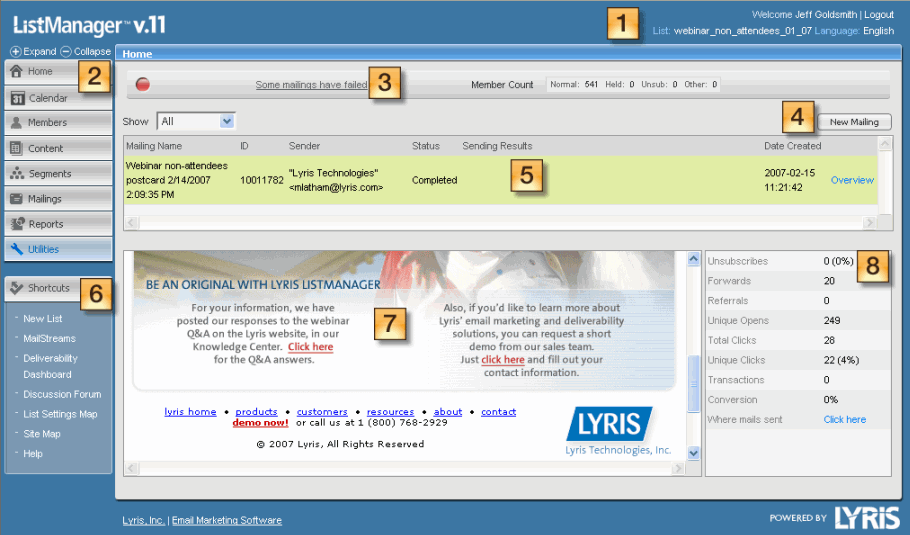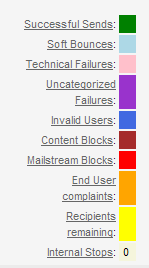
The ListManager Homepage is the first page you see after you log in. The Homepage displays the most recent information about the list you are logged into, and provides shortcuts to frequently performed tasks.
NOTE: ListManager generates the reporting statistics on the Homepage once per day, or according to the frequency set by the server administrator.

 Login Information
Login Information
Shows you your current list, the current language you are using, and your login name. If you are running a ListManager cluster and you are a server administrator, the node name will appear as well.
TIP: You can click the list name to change your list, click the current language to switch to another language, or click your name to log in as another user.
 Navigation Bar Tabs
Navigation Bar Tabs
You can navigate between the major areas of ListManager by clicking on one of the Navigation bar tabs.
Home
Select the Home tab to return to the Homepage.
Calendar
Select the Calendar tab to view, schedule, and edit your events and mailings.
Members
Use the Members tab to add, import, find, edit, and delete members. For more information about members, see Members -- Overview.
Content
Use the Content tab to create, view, copy, and delete content. For more information about content, see Content -- Overview.
Segments
Use the Segments tab to create, view, copy, and delete segments. For more information about segments, see Segments -- Overview.
Mailings
Use the Mailings tab to create, view, copy, test, schedule, approve, or delete mailings. For more information about mailings, see Mailings -- Overview.
Reports
Use the Reports tab to view reports for a mailing, for example the progress and how successful the mailing is. In addition, you can view clickthrough statistics, and information about your membership. For more information about reports, see Reports -- Overview.
Utilities
Use the Utilities tab to manage your list settings and members, as well as see the mail that's coming from and to your server, set up autoresponders, manage the server, and create documents to be sent automatically when people confirm or subscribe. For more information about utilities, see Utilities -- Overview.
 Mailing Status
Mailing Status
Displays the current mailing status of the list, and the number of active, normal members.
If there are no problems sending mail, ListManager will display a green icon with a message indicating mail sending is normal.
If a mailing could not be generated as expected (no recipients to send to, or a corrupted message) ListManager will display a red icon.
To clear the warning, click it to see a list of unprocessed incoming mail messages. Scroll down to Status, check the box next to "acknowledged", and click ok.
The Mailing Status area also displays any system-wide messages from the server administrator. If there are no notices, this box will not appear. The server administrator may enter a message to be displayed here in Utilities: Administration: Server: Server Settings: Basic Settings: Interface Messages.
 New Mailing
New Mailing
Click this button to create a mailing.
 Recent Mailings
Recent Mailings
This area displays the recent mailings and deliverability status for the current list. To display a mailings from a different time period (for example, last week or last month) or a particular campaign, click Show, and then choose from the list.
Mailing Name
The title of the mailing displayed.
ID
A unique identification number assigned to that specific mailing.
Sender
The name that appears in the message From: field.
Status
The status of this mailing. The possible statuses are:
Active - Recipients are pending delivery.
Paused - The mailing has been paused by an administrator.
Completed - Delivery to all recipients is completed.
Sending Results
Each mailing has a colored gauge that lets you know its deliverability status. The colors represent the percent of the mailing in each of the major statuses:

Successful Sends: The number of emails that were successfully received by recipients.
Soft bounces: Email that has bounced back to the sender undelivered after it has been accepted by the recipient's mail server.
Technical failures: Technical failures are failures of the delivery of email due to problems on the receiving equipment or infrastructure, such as DNS resolution issues, connection timeouts, greylisting, or server errors due to non-user specific disk space problems.
Uncategorized failures: A failure that doesn't easily fit into one of the other categories.
Invalid Users: For some reason, the email addresses are not legitimate ones (this is often caused by spelling errors).
Content Blocks: Content blocks are responses that indicate that the message is rejected for issues detected by a content filter. The filter may conclude that your message contains spam-like content, non-RFC compliant content, blacklisted URLs in the content, etc
MailStream blocks: You can learn more about MailStream blocks here.
End User complaints: Spam complaints made about the mailing.
Recipients remaining: The number of recipients for a mailing that are current pending in the Active Recipients queue. These users may not have been attempted yet, could be in retry due to transient delivery failures, or could be inactive due to a block by the destination ISP.
Date Sent
The date and time the message was queued to be sent.
"Overview" command
Click the Overview command for a mailing to go to the Mailing Overview page for that mailing.
 Shortcuts
Shortcuts
This bar displays links to commonly performed tasks. The links available here vary according to your administrative permissions. For example, the link to create a new list only appears for site and server administrators.
 Mailing Preview
Mailing Preview
Displays a preview of the mailing selected in Recent Mailings area.
 Mailing Statistics
Mailing Statistics
Shows all trends that indicate whether the percentage or number expressed increased or decreased since the last mailing.
Unsubscribes
# - The number of unsubscribes attributable to this mailing. ListManager is able to attribute unsubscribes to a particular mailing if the mailing uses the %%email.unsub%% or %%url.unsub%% tags to unsubscribe members. Click this number to be taken to a chart comparing recent unsubscribe counts.
% - The number of unsubscribes as a percentage of the number of successful deliveries.
Forwards
The number of forwards recorded for this mailing. A forward is a message that has been opened on computers with different IP addresses. Forwards tracking requires that you have opens tracking enabled. Click this number to be taken to a chart comparing forwards for recent mailings.
Referrals
The number of referrals recorded for this mailing. Referral tracking requires that you have refer a friend tracking in your mailing. Click this number to be taken to Reports: Mailings: Referral Statistics.
Unique Opens
# - The number of unique opens detected for this mailing. Opens tracking must be enabled for unique opens to be displayed. Click this number to be taken to a chart comparing recent unique open rates.
% - The number of unique opens as a percentage of the number of successful deliveries.
Total Clicks
# - The total number of clickthroughs for this mailing on all links. At least one URL must have been a tracking URL for clickthrough rates to be counted. Click this number to be taken to a chart comparing recent total clickthrough rates.
Unique Clicks
# - The number of recipients who have clicked at least one link in the mailing. Click this number to be taken to a chart comparing recent unique clickthrough rates.
% - The number of recipients who have clicked at least one link in the mailing as a percentage of the number of successful deliveries.
Transactions
# - The number of purchases recorded for this mailing. Purchase tracking must be enabled for transactions to be counted. Click this number to be taken to a chart of cumulative purchase over time.
$ - The amount purchased as a result of this mailing.
Conversion
% - The number of recipients who made a purchase as a percentage of the number of successful deliveries.
Where Mails Sent
Opens the Map Report, which displays a breakdown of results according to state or province.